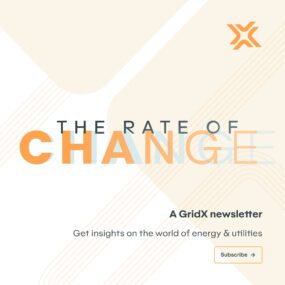4 questions with Chris Black, CEO of GridX
Brad Langley, GridX VP of Marketing, sits down with Chris Black, GridX CEO, to discuss GridX’s 2023 outcome and his thoughts on upcoming trends in 2024.

Brad Langley, GridX VP of Marketing, sits down with Chris Black, GridX CEO, to discuss GridX’s 2023 outcome and his thoughts on upcoming trends in 2024.


Chris Black, GridX CEO
Brad: 2023 was a very successful year for us here at GridX. What are you most proud of?
Chris: Objectively, it has been successful. We progressed against our goals and delighted our customers with our solutions and engagements. Certainly the board of directors is happy, so I think we are on the right track.
But by far the thing that I’m most proud of is our team. I really feel like we have such strong alignment across the company and we’ve built a culture that is fun to be a part of. Everyone knows what we are doing, why we are doing it, what impact it has, and how what they do creates value. We spent a year and a half really focused on building the right people, processes, and tools to create a really healthy company and now it feels like the best thing I can do is get out of the way and let all of our amazing people do amazing things.
I take a lot of pride in what the company feels like today, but it’s also a weird feeling to take my hands off the wheel a bit and let 130 others do the driving.
Brad: Give us one trend to look out for next year as it relates to utility rates & pricing.
Chris: In a word: ‘Complexity’. Gone are the days of simple rate and pricing structures. The nearly overnight shift toward greater electrification, prosumer models, and demand-side complexity – all while aggressively decarbonizing – means that the status quo of supply following demand is dead.
The new paradigm is that demand must follow supply if we want to achieve our decarbonization goals and support the new electric consumer. The old model assumed a fairly static and slow load growth and, frankly, there are not economically-viable solutions available today if everyone decided to be an EV owner. Most of the infrastructure out there today couldn’t handle a 2x load increase. That means if 2 or 3 neighbors all get EVs, most likely the transformer they are attached to would be pretty unhappy. And by the way, this is the way that EVs spread; virally through the “keeping up with the Joneses” effect, so it isn’t a hypothetical situation.
This means that we need dynamic rates and prices that reflect the real time mix of renewables on the grid and we need these price signals to drive the actions on the demand side. Things like locational and dynamic pricing, combined with prices to devices are the way that the industry is moving in order to extend the life of the existing infrastructure to get maximum efficiency while simultaneously improving the overall customer experience.
GridX is leading this charge with our innovative utility partners, who are the tip of the spear for this new paradigm. It’s an exciting time.
Brad: If you could give one piece of advice for utilities looking to implement or maximize their TOU offerings, what would it be?
Chris: It would be “Stop doing it the old way”. Per my “complexity” answer above, rates are much more complex than they used to be and are only getting more complex. Trying to do this on spreadsheets and running these spreadsheet-based models through a sample of the populations just doesn’t work anymore. It doesn’t work from a correctness perspective nor a time to market perspective. The number of rates and the complexity of rates are growing in direct proportion to the demand-side load growth tied to DER adoption.
Instead, leverage fit for purpose tools that allow you to better design and analyze the impact of any rate or rate change. Also, let’s not forget that getting the rate design done and approved is only step one. Once you’ve done so, you then have to get it implemented in the billing system which introduces yet more chances for error and delays. It is an extremely difficult task to take a fairly high-level rate design, as specified in the rate case, and correctly implement the rate in the black box of the legacy billing system. Instead, the right enterprise rate platform should allow you to easily add support for complex programs by being natively “rates aware” and play nicely with your legacy billing system – ready to bill as soon as the rate is approved.
I know all of this is self-serving for GridX but it is the biggest issue we see within our utility partners – trying to tackle this new world using the tools of the old world.
Brad: You speak with a lot of utility executives. Any common themes from those conversations about what has people excited or nervous in terms of achieving our decarbonization targets?
Chris: I think most utilities are both excited and nervous at the same time. I think there is consensus that we have the tools that we need in order to achieve it – largely, but the “how” and “how soon” are the problems. Business model changes, large-scale operating changes, and regulatory changes are going to be required in order to do so.
We have sufficient renewable solutions to make achieving net-zero goals feasible today. But to actually leverage these solutions to fully achieve our goals, more parts of the country need more adoption of these solutions. This proposal quickly meets three areas of friction:
1) Friction point #1: Doing so requires business model and regulatory changes to allow utilities to better participate in the economics of these solutions.
2) Friction point #2: The traditional utility model of “death by pilot”. I fully understand and appreciate the need for ensuring that reliability, safety, and security are priority #1, but 100 years of this mindset has meant that innovation moves slower and, frankly, we don’t have the time for the typical model.
3) Friction point #3: Even if we had all of these solutions deployed at sufficient scale, we need to leverage the right signals at the demand side of the equation to ensure usage aligns with the presence of the intermittent renewables. TOU and other modern rates are an incredibly powerful mechanism to achieve this but utilities are often slow to roll out TOU rates at full-scale. Most customers do better under a TOU rate. This is great for consumers, but can mean lost revenue for utilities. Again, this is where business model changes, better analytics, and better program design can help and GridX is here to help our utility partners make the transition.

How Utilities Can Ensure Everyone Benefits from Affordable Electrification
To achieve our decarbonization, air quality, and climate goals, we must electrify appliances and vehicles.




